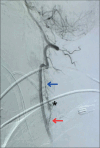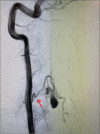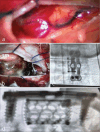Endovascular embolization combined with anterior cervical corpectomy for treatment of cervical spinal dural arteriovenous fistula
- PMID: 39372985
- PMCID: PMC11450874
- DOI: 10.25259/SNI_657_2024
Endovascular embolization combined with anterior cervical corpectomy for treatment of cervical spinal dural arteriovenous fistula
Abstract
Background: The two main treatments for spinal dural arteriovenous fistula (SDAVF) include microsurgical occlusion or endovascular embolization (i.e., the latter alone has high recurrence rates). Here, we combined both strategies to treat/obliterate a cervical SDAVF more effectively.
Case description: A 34-year-old male presented with a marked decline in mental status attributed to an infratentorial subarachnoid hemorrhage. The left vertebral angiogram revealed a ruptured, low cervical SDAVF. He underwent successful occlusion of the spinal fistula utilizing super selective catheterization and endovascular embolization (i.e., utilizing Onyx-18 for the obliteration of target arteries). Due to significant SDAVF accompanying vessel recruitment/complex angioarchitecture, we additionally performed a C5 anterior corpectomy/fusion to afford direct access and complete surgical SDAVF occlusion. Three and 6 months later, repeated angiograms confirmed no recurrent or residual SDAVF.
Conclusion: We successfully treated a low cervical SDAVF using a combination of endovascular embolization and direct surgical occlusion through an anterior C5 corpectomy with a fusion approach.
Keywords: Anterior cervical approach; Corpectomy; Endovascular embolization; Hybrid strategy; Spinal dural arteriovenous fistula.
Copyright: © 2024 Surgical Neurology International.
Conflict of interest statement
There are no conflicts of interest.
Figures





References
-
- Cenzato M, Debernardi A, Stefini R, D’Aliberti G, Piparo M, Talamonti G, et al. Spinal dural arteriovenous fistulas: Outcome and prognostic factors. Neurosurg Focus. 2012;32:E11. - PubMed
-
- El Naamani K, Tjoumakaris SI, Gooch MR, Jabbour P. Dural arteriovenous fistula. Neurosurg Clin N Am. 2024;35:331–42. - PubMed
-
- Flores BC, Klinger DR, White JA, Batjer HH. Spinal vascular malformations: Treatment strategies and outcome. Neurosurg Rev. 2017;40:15–28. - PubMed
-
- Koch MJ, Stapleton CJ, Agarwalla PK, Torok C, Shin JH, Coumans J, et al. Open and endovascular treatment of spinal dural arteriovenous fistulas: A 10-year experience. J Neurosurg Spine. 2017;26:519–23. - PubMed
Publication types
LinkOut - more resources
Full Text Sources
Miscellaneous
